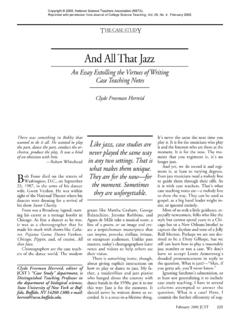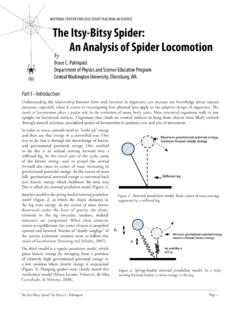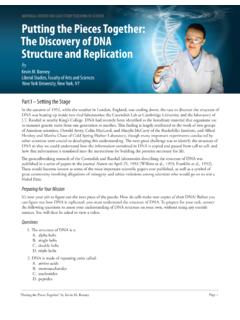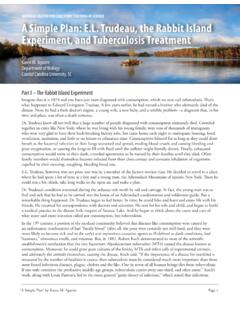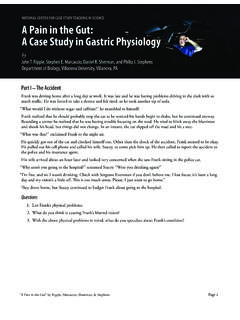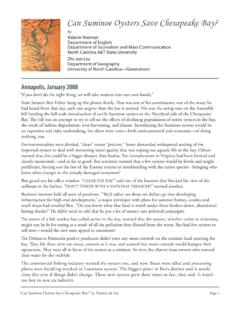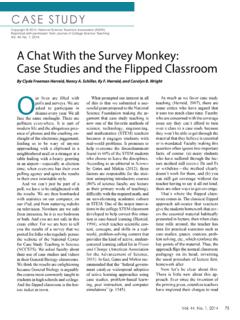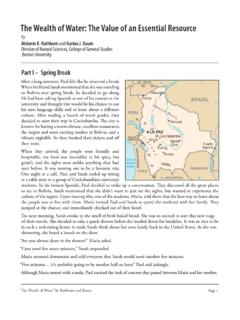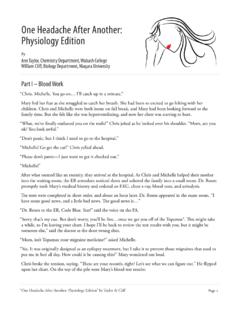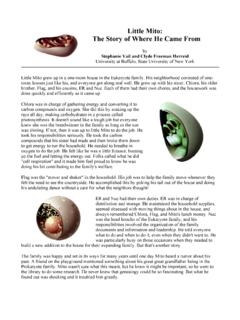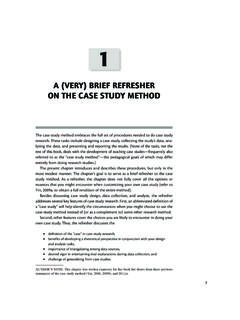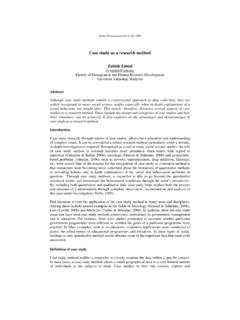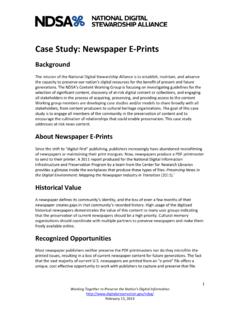Transcription of THE CASE STUDY - sciencecases.lib.buffalo.edu
1 156 JCST December 1999/January 2000 There are more books publishedon the subject of cooking than onany other topic. Wander into anybookstore and you will witness the cu-linary literature yourself. Face to faceyou will meet Betty Crocker, FannieFarmer, Julia Child, James Beard, andtheir culinary buddies waiting tocharm you into gastronomic imagin-ings and entreating you to plunk down$ for their newest literary too far away, on nearby shelves,you will find books on how to garden,how to play the guitar, how to medi-tate with the latest guru, how to repairyour Honda, and how to get right withGod. There are instruction manualsfor everything from becoming a magi-cian to becoming, well, are even books on how to be-come a great teacher.
2 Yet at Barnes &Cooking with Betty CrockerA Recipe for case WritingClyde Freeman HerreidClyde Freeman Herreid, editor ofJCST s case STUDY department, isDistinguished Teaching Professor inthe department of biological sciences,State University of New York at Buf-falo, Buffalo, NY 14260-1300; into mixing bowl cup ofwarm water, 2 pkg. dry yeast. Add 1- cups lukewarm scalded milk. Stirin 7 cups sifted flour, 3 tbsp. sugar,1 tbsp. salt, 2 tbsp. shortening. Beatwith a spoon, cover, knead, let into loaves. Bake at 425 . Betty Crocker recipe for whitebread, two loavesNoble or Borders you are unlikely tofind them. In spite of the growingnumbers of books on this topic, theyare poor sales prospects for the bookseller.
3 These books will hardly ever betouched by the average college teacherwho probably doesn t even know oftheir existence, much less have one onhis cluttered in mind this neglectedniche of publishing, and the flood ofarticles on education written each yearthat will never be seen by the practi-tioners in most classrooms, I am stillready to add another few thousandwords, this time on the topic of howto write case do believe that somewhere, some-how, an occasional person will actuallyread them and just possibly find some-thing of use. It is akin to the wish thata person standing on a pier might haveas he scribes a note and pops it into abottle, caps it, and hurls it into the sea,wondering if anyone will ever find keeping with the cooking themeand addressing our concerns to casestudy teaching, let us pose the follow-ing question.
4 Is there any recipe forcreating a case ? Is there something asdependable as a white bread approachto cases? Straightforward. Nothingfancy. Fortunately, the answer is before we start cooking, let s laydown a few when a teacher gets in-spired to write a case , he has a coursein mind. He knows the students tak-ing the course, their numbers, andbackground. He knows the guests thatare coming to dinner, but he hasn tdecided on the meal. What he doesn tknow is how this case that he hopes toconcoct is going to fit in. (After all, itisn t written yet.) Nor does he knowwhat it will teach exactly or what it willreplace on the syllabus. Take a tip don t worry about this yet. It s toosoon to that the general background isknown, it is useful to point out thatthere are two general approaches.
5 Onemethod is to start out listing generalprinciples that you wish to teach, thenstart looking for a good story thatmight teach them. The other approachis to spot a good story that seems anappropriate fit for your course, thenask yourself what principles you can il-lustrate with the avenue you choose, youmust choose reasonably soon what typeof case -teaching method you will it be Problem-Based Learning(PBL) with small groups, or discussionbased, or a debate, or .. ? This deci-sion can be put off for a time whileyou do some research on the topic, butit can t be delayed too long becauseyour writing will be largely driven bythe case method of is one other set of principlesto review before beginning.
6 They areones that I listed in a previous column, What Makes a Good case ? (JCST,Dec. 1997/Jan. 1998, pp. 163-165). Agood case tells a story, is set in the pastfive years, creates empathy with thecentral characters, includes quotations,is relevant to the reader, serves a peda-gogical function, requires that dilem-mas be solved, has generality, and isTHE case STUDYC opyright Dec 1999/Jan 2000, National Science Teachers Association (NSTA). Reprinted with permission from Journal of College Science Teaching, Vol. 29, No. 3, Dec 1999/Jan 1999/January 2000 JCST157Is there any recipe for creating a case ?Is there something as dependable as a white breadapproach to cases? Fortunately, the answer is These rules are not sacrosanctbut they work most of the let s suppose I decide to write acase STUDY , what steps can I take to getthe job done?
7 S First, you have to decide on a you already have a story line that in-trigues you, this isn t a problem, butlet s suppose that that isn t the situa-tion. The next best option is to thinkof one or more topics that are impor-tant to your course. Is there any con-flict, controversy, news item, or per-sonal experience that is associated withthe topic? If so, all the better. Askyourself: Can the topic be linked toany contemporary problem such asglobal warming, environmental disas-ter, social issues? This is the hook (in-terest-provoking item) into the Review and research the topic and thehook into the material so that you cansee further connections and Rapidly write down all the possibleprinciples that you might teach using thistopic in your class.
8 Don t evaluate theseideas at this time; you are brainstorm-ing. But remember that when you startwriting you are going to try and slipas many of these delicacies into yourdish as Make a list of all the possible charac-ters (fictional or real) who could bepossibly affected by this topic or inci-dent. Do any of these people haveproblems to be solved?s Write a draft of a case from the view-point of a person caught in the thick ofthe case problem. If there is a crisislooming, so much the better. The casecan be written in a straightforward nar-rative, although techniques used byshort story writers ( , flashback anddialogue) are you are writing for PBL courses,then the story line must be broken intotwo or three parts.
9 In PBL, the stu-dents receive a page or two of theopening, then they need to do researchbefore receiving subsequent As you write these sections look foropportunities to introduce terms or con-cepts that are important to your all of these must have been cov-ered previously. You want the studentsto research these items as part of theirpreparation for the After you have a draft, go through thecase again and list the major and minortopics that are likely to come up in a dis-cussion of the case . Hopefully, you willbe surprised at the number of topicsthat you have slipped in, some thatyou originally had not After you have a reasonable versionof the case , write a series of discussionquestions to include at the end of eachsection.
10 These STUDY questions will as-sist your students to recognize the im-portant issues embedded in the some revision here and there,your case is finished. There is still theissue of how to manage the case in theclassroom. That will take careful plan-ning. It may be straightforward, or itmay be elaborate with role playing andstudent research. We ll leave that foranother day. Here I would like to il-lustrate how we developed a recent caseusing the above steps. You will noticeright away that the steps didn t comein the order that I mentioned above,yet the steps are all me set the scene. A librarian(we ll call her Nancy) wanted to trywriting a case STUDY for my freshmanEvolutionary Biology class. She hadbeen interested in the Galapagos Is-lands for some time and was aware thatthey had played a significant role inDarwin s ideas on evolution.
